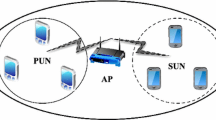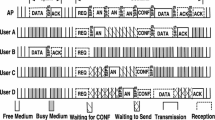Abstract
In wireless local area networks (WLANs), the traditional carrier sense multiple access with collision avoidance (CSMA/CA) medium access control (MAC) protocol cannot use the full benefits from multiuser multiple-input multiple-output (MU-MIMO) technique due to random medium access of the users. In this paper, we propose a carrier sensing based MAC protocol for a MU-MIMO based WLAN with full utilization of MU-MIMO technique. By modeling the WLAN system under the proposed MAC protocol as a discrete time Markov chain, we develop an analytical model for computing the saturation throughput in presence of path loss, Rayleigh fading and log-normal shadowing. The analytical model is then validated via simulation. By means of numerical and simulation results, we demonstrate that the proposed MAC protocol significantly improves throughput performance than the traditional CSMA/CA MAC protocol. Further, we compare the performance of the proposed MAC protocol with a MU-MIMO MAC protocol called Uni-MUMAC protocol and find that the proposed MAC protocol performs better than the Uni-MUMAC protocol. We also explore the effect of some of the network and wireless channel parameters on the performance of the proposed MAC protocol.









Similar content being viewed by others
Notes
In the protocol interference model, the received signal strengths of all the received signals are assumed to be equal.
References
Raoof, K., Khalighi, M., & Prayongpun, N. (2008). MIMO systems: Principles, iterative techniques and advanced polarization. Adaptive Signal Processing for Wireless Communication, 2, 95–134.
Tse, D., Viswanath, P., & Zheng, L. (2004). Diversity-multiplexing tradeoff in multiple access channels. IEEE Transactions on Information Theory, 50(9), 1859–1874.
Jin, H., Jung, B. C., & Sung, D. K. (2011). A trade off between single-user and multi-user MIMO schemes in multi-rate uplink WLANs. IEEE Transactions on Wireless Communications, 10(10), 3332–3342.
Uddin, M. F. (2013). Joint routing and scheduling in fixed multi-user MIMO wireless multi-hop networks. In Proceedings of the IEEE/CIC ICCC (pp. 745–751).
Gesbert, D., Kountouris, M., Heath, R. W, Jr., Chae, C. B., & Salzer, T. (2007). From single user to multiuser communications: Shifting the MIMO paradigm. IEEE Signal Processing Magazine, 24(5), 36–46.
Chowdhury, M. M. U., Tanveer, M. A. & Uddin, M. F. (2014). Performance analysis of CSMA/CA based MU-MIMO WLANs. In Proceedings of the international conference on electrical and computer engineering (ICECE) (pp. 398–401).
IEEE Std. 802.11. (1997). Wireless LAN medium access control (MAC) and physical layer (PHY) specifiation. New York: IEEE.
IEEE Draft Standard for Information Technology LAN/MAN Part 11: Wireless LAN Medium Access Control and Physical Layer Specifications Amendment. (2013). Enhancements for very high throughput for operation in bands below 6 GHz. IEEE P802.11ac/D6.0. (pp. 1–446).
Skordoulis, D., Ni, Q., Chen, H. H., Stephens, A. P., Liu, C., & Jamalipour, A. (2008). IEEE 802.11n MAC frame aggregation mechanisms for next-generation high-throughput WLANs. IEEE Wireless Communications Magazine, 15(1), 40–47.
Barghi, S., Jafarkhani, H., & Yousefizadeh, H. (2011). MIMO-assisted MPR-aware MAC design for asynchronous WLANs. IEEE/ACM Transactions on Networking, 19(6), 1652–1665.
Zhou, S., & Niu, Z. (2010). Distributed medium access control with SDMA support for WLANs. IEICE Transactions, 93(4), 961–970.
Liao, R., Bellalta, B., & Oliver, M. (2012). DCF/USDMA: Enhanced DCF for Uplink SDMA Transmissions in WLANs. In Proceedings of the IWCMC (pp. 263–268).
Zhang, Y. J. (2010). Multi-round contention in wireless LANs with multipacket reception. IEEE Transactions on Wireless Communications, 9, 1503–1513.
Cai, L. X., Shan, H., Zhuang, W., Shen, X., Mark, J. W., & Wang, Z. (2008). A distributed multi-user MIMO MAC protocol for wireless local area networks. In Proceedings of the IEEE GlobeCom (pp. 4976–4980).
Liao, R., Bellalta, B., Minh, T. C., Barcelo, J., & Oliver, M. (2015). Uni-MUMAC: A unified down/up-link MU-MIMO MAC protocol for IEEE 802.11 ac WLANs. Wireless Networks, 21(5), 1457–1472.
Iyer, A., Rosenberg, C., & Karnik, A. (2009). What is the right model for wireless channel interference? IEEE/ACM Transaction on Networking, 8(5), 2662–2671.
Liao, R., Bellalta, B., Oliver, M., & Niu, Z. (2016). MU-MIMO MAC protocols for wireless local area networks: A survey. IEEE Communications Surveys and Tutorials, 18(1), 162–183.
Jin, H., Jung, B. C., Hwang, H. Y., & Sung, D. K. (2008). Performance comparison of uplink WLANs with single-user and multi-user MIMO schemes. In Proceedings of the IEEE WCNC (pp. 1854-1859).
Ettefagh, A., Kuhn, M., Esli, C., & Wittneben, A. (2011). Performance analysis of distributed cluster-based MAC protocol for multiuser MIMO wireless networks. EURASIP Journal on Wireless Communications and Networking, 1(34), 1–14.
Mukhopadhyay, A., Mehta, N. B., & Srinivasan, V. (2012). Acknowledgement-aware MPR MAC protocol for distributed WLANs: Design and analysis. In Proceedings of the IEEE GlobeCom (pp. 5087–5092).
Lin, T. -H., & Kung, H. (2013). Concurrent channel access and estimation for scalable multiuser mimo networking. In Proceedings of the ACM INFOCOM (pp. 140–144).
Tan, K., Liu, H., Fang, J., Wang, W., Zhang, J., Chen, M., & Voelker, G. M. (2009). SAM: enabling practical spatial multiple access in wireless LAN. In Proceedings of the ACM INFOCOM (pp. 49–60).
Zheng, P. X., Zhang, Y. J., & Liew, S. C. (2006). Multipacket reception in wireless local area networks. In Proceedings of the IEEE ICC (Vol. 8, pp. 3670–3675).
Kartsakli, E., Zorba, N., Alonso, L., & Verikoukis, C. V. (2009). Multiuser MAC protocols for 802.11n wireless networks. In Proceedings of the IEEE ICC (pp. 1–5).
Gong, M. X., Perahia, E., Stacey, R., Want, R., & Mao, S. (2010). A CSMA/CA MAC protocol for multi-user MIMO wireless LANs. In Proceedings of the IEEE GlobeCom (pp. 1–6).
Kim, T., & Vaidya, N. (2008). MAC protocol design for multiuser MIMO wireless networks. Technical Report, University of Illinois at Urbana-Champaign.
Li, H., Attar, A., & Leung, V. C. M. (2010). Multi-user medium access control in wireless local area network. In Proceedings of the IEEE WCNC (pp. 1–6).
Yun, S., Qiu, L., & Bhartia, A. (2013). Multi-point to multi-point MIMO in wireless LANs. In Proceedings of the ACM INFOCOM (pp. 125–129).
Bianchi, G. (2000). Performance analysis of the IEEE 802.11 distributed coordination function. IEEE Journal on Selected Areas in Communications, 18(3), 535–547.
Ni, Q., Li, T., Turletti, T., & Xiao, Y. (2005). Saturation throughput analysis of error-prone 802.11 wireless networks. Journal of Wireless Communications and Mobile Computing, 5(8), 945–956.
Jiang, L., & Walrand, J. (2011). Approaching throughput-optimality in a distributed CSMA algorithm: Collisions and stability. IEEE/ACM Transactions on Networking, 19(23), 816–823.
Ni, J., Tan, B., & Srikant, R. (2010). Q-CSMA: Queue length-based CSMA/CA algorithms for achieving maximum throughput and low delay in wireless networks. In Proceedings of the IEEE INFOCOM Mini-Conference (pp. 1–5).
Qian, D., Zheng, D., Zhang, J., Shroff, N. B., & Joo, C. (2013). Distributed CSMA algorithms for link scheduling in multihop MIMO networks under SINR model. IEEE/ACM Transactions on Networking, 21(3), 746–759.
Hadzi-Velkov, Z., & Spasenovski, B. (2002). Capture effect in IEEE 802.11 basic service area under influence of rayleigh fading and near/far effect. In IEEE personal indoor and mobile radio communications symposium (pp. 172–176).
Kim, J. H., & Lee, J. K. (1999). Capture effects of wirelss CSMA/CA protocols in Rayleigh and shadow fading channels. IEEE Transactions on Vehicular Technology, 48, 1277–1286.
Li, X., & Zeng, Q. (2006). Performance analysis of the IEEE 802.11 MAC protocols over a WLAN with capture effct. Information and Media Technologies, 1, 679–685.
Uddin, M. F. (2016). Throughput analysis of a CSMA based WLAN with successive interference cancellation under Rayleigh fading and shadowing. Wireless Networks, 22(4), 1285–1298.
Uddin, M. F., & Mahmud, M. S. (2017). Carrier sensing based medium access control protocol for WLANs exploiting successive interference cancellation. IEEE Transaction on Wireless Communication, 16(6), 4120–4135.
Babich, F., & Comisso, M. (2010). Theoretical analysis of asynchronous multi-packet reception in 802.11 networks. IEEE Transactions on Communications, 58(6), 1782–1794.
Wu, S., Mao, W., & Wang, X. (2014). Performance study on a CSMA/CA-Based MAC protocol for multi-user MIMO wireless LANs. IEEE Transactions on Wireless Communications, 13(6), 3153–3166.
Wang, C., Au, E. K., Murch, R. D., Mow, W. H., Cheng, R. S., & Lau, V. (2007). On the performance of the MIMO zero-forcing receiver in the presence of channel estimation error. IEEE Transactions on Wireless Communications, 6(3), 805–810.
Cha, J., Jin, H., Jung, B. C., & Sung, D. K. (2012). Performance comparison of downlink user multiplexing schemes in IEEE 802.11ac: Multi-user MIMO vs. frame aggregation. In Proceedings of the IEEE WCNC (pp. 1514–1519).
Uddin, M. F., Rosenberg, C., Zhuang, W., Mitran, P., & Girard, A. (2014). Joint Routing and medium access control in fixed random access wireless multihop networks. IEEE/ACM Transactions on Networking, 22(1), 80–93.
Rao, S. S. (2002). Applied numerical methods for engineers and scientists (pp. 588–605). Upper Saddle River: Prantice Hall.
Author information
Authors and Affiliations
Corresponding author
Appendices
Appendix 1: Computation of \(\sum _{d \in {\mathcal {N}},e \in {\mathcal {N}}{\setminus} d}\psi (S_{d,e},1)\)
From the transition probabilities of row number 1 in Table 1, we obtain
From the transition probabilities of row number 4 in Table 1, one can show that
By using transition probabilities of row number 2 in Table 1 and the relation \(\sum _{d\in m} P_{m,d}^c=P_{m}^c\), we find,
where,
The balance equation for the state \(S_d\) can be expressed as
After some mathematical manipulations, from (23) one can show that
where,
From the transition probabilities shown in row number 7 of Table 1 and the Eq. (26), one can show that
From the transition probabilities shown in row numbers 7, 8 and 10 in Table 1 and Eqs. (25), (26) and (27), we find
Appendix 2: Computation of \(\psi (S_0)\)
Since \(\sum _{s}\psi (s)=1\), one can obtain the expression in (29).Since the transmission probability is one from one mini-slot to next mini-slot of a packet transmission, (29) can be written as in (30).Further, from the transition probabilities in row numbers 17 to 20 of Table 1, it can be observed that \(\psi (RT_{d^\prime ,e^\prime }, 1)= \psi (S_{d^\prime ,e^\prime },1)=\psi (S_{d^\prime ,e^\prime },DT^\prime _{d^\prime ,e^\prime },1)\). Thus, using (18), (21) and (26)–(28), (30) can be written as in (31).
From (4) and (8), the expression of \(\sum _{\forall d \in {\mathcal {N}},\forall e \in {\mathcal {N}}{\setminus} d}\psi (S_{d,e},DT_{d,e},1)\) and from (10) and (11), the expression of \(\sum _{\forall d^\prime \in {\mathcal {N}}, \forall e^\prime \in {\mathcal {N}} {\setminus} d^\prime } \psi (S_{d^\prime ,e^\prime },DT^\prime _{d^\prime ,e^\prime },1)\) can be obtained and then using those expressions in (31), we obtain
If \(N \gg 2\) and p is small, \(K_N \approx K_{N-1}\), and \((1-p)^N \approx (1-p)^{N-1}\) and hence, from (32) \(\psi (S_0)\) can be obtained as
For general case, \(\psi (S_0)\) can be written as
Thus, the expression of \(\psi (S_0)\) can be found as in (9).
Rights and permissions
About this article
Cite this article
Sarker, M., Uddin, M.F. Saturation throughput analysis of a carrier sensing based MU-MIMO MAC protocol in a WLAN under fading and shadowing. Wireless Netw 25, 933–950 (2019). https://doi.org/10.1007/s11276-017-1614-y
Published:
Issue Date:
DOI: https://doi.org/10.1007/s11276-017-1614-y




